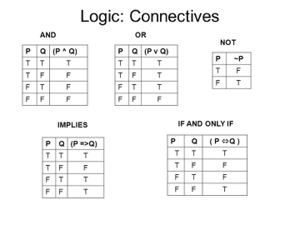Logical connectives
Main Entry NameTheTrait
Logical Connectives
It may be helpful to understand the following basics of logical connectives and propositional logic, before reading the following sections.
In propositional logic simple statements (referred to as propositional atoms) are assigned letters such as P or Q etc., and complex statements are formed by connecting these statements with logical connectives (as seen in the picture to the right). As an example
- P = I live in Paris
- Q = I live in Quebec
- N = I am Napoleon
- (P ∧ ¬Q) = I live in Paris and I don't live in Quebec
- (N ⇒ (P ∧ ¬Q)) = If I am Napoleon then I live in Paris and not Quebec
Now using the truth tables of the logical connectives we can determine whether a statement is true or false. If we consider the previous example, we can evaluate the truth of the statement a number of cases.
(1) In the case that you are not Napoleon, and you live in New York.
- P is false, Q is false, ¬Q is true, and N is false, so
- (P ∧ ¬Q) is false (false and true gives false)
- (N ⇒ (P ∧ ¬Q)) is true (false implies false gives true)
So the statement 'if I am Napoleon then I live in Paris and not Quebec' is true, in this case
(2) In the case that you are Napoleon, and you live in Quebec
- P is false, Q is true, ¬Q is false, and N is true, so
- (P ∧ ¬Q) is false (false and false gives false)
- (N ⇒ (P ∧ ¬Q)) is false (true implies false gives false)
So the statement 'if I am Napoleon then I live in Paris and not Quebec' is false, in this case
In the following section we translate NTT into first order logic (which is more complicated than propositional logic), then construct counterexamples and evaluate the truth of the premises and conclusion, in a similar manner to above. Showing in fact that there are cases where P1 and P2 of the NTT argument are true and the conclusion is false
